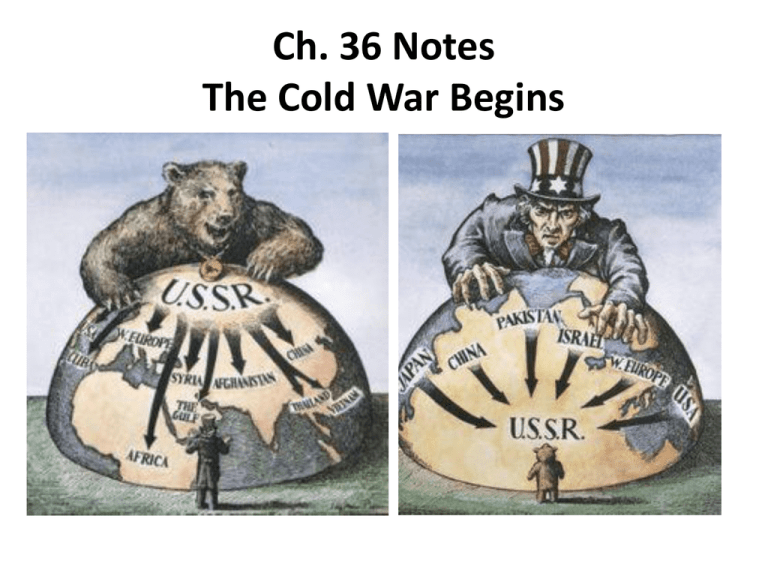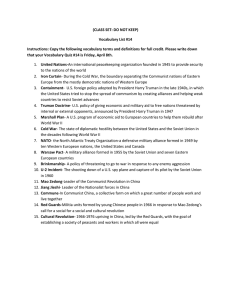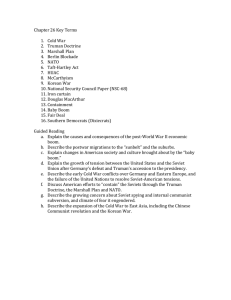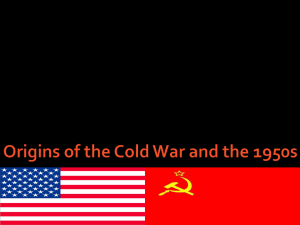Ch. 36 Notes The Cold War Begins
advertisement

Ch. 36 Notes The Cold War Begins Post WWII Economic Fears 1. The biggest fear for the U.S. immediately after WWII was of another depression. 2. As wartime production began to fall off, layoffs began to occur – yet over a million veterans were about to return from war. 3. As wartime price controls were removed, inflation soared. 4. In 1946, 4.5 million workers went on strike. Truman and Unions 1. Truman refused to let the country be crippled by strikes – he threatened to draft striking workers into the military and then order them back to work as soldiers – this strategy worked fairly well. 2. In 1947 Congress passed the Taft-Hartley Act to try to slow labor unrest by giving judges the power to stop strikes with injunctions, outlawing “closed shop” agreements, limiting unions’ political contributions and making union officers take oaths of loyalty. 3. Truman vetoed the Taft-Hartley Act but Congress overrode his veto. 4. Unions referred to it as the “slave-labor bill”. Truman and the Economy 1. To stimulate the economy, the federal government sold off government-owned factories to private businesses at incredibly low prices. 2. Congress passed the Employment Act of 1946, which made it government policy to promote full employment, production and purchasing power. 3. The Employment Act also created the President’s Council of Economic Advisors to aid in this endeavor. 4. And to aid the returning soldiers, Congress passed the Serviceman’s Readjustment Act. The G.I. Bill of Rights 1. The Servicemen’s Readjustment Act, or the G.I. Bill of Rights (GI Bill) made generous provisions for sending veterans back to school and gave them low-interest loans to assist in buying homes, farms or small businesses. 2. This law will improve education levels and stimulate the construction industry in the U.S., which we play a large role in the U.S.’s post WWII economic boom and the growth of the U.S.’s middle class. 1. To aid veterans in finding housing, William Levitt developed a method to mass-produce houses, which led to the U.S.’s first “cookie-cutter” suburb, Levittown. 2. Using the assembly-line method, over 30 homes could be built in a day, all for which sold for around $7,000. The Growth of the Suburbs LEVITTOWN, New York The first American Suburb The Growth of the Suburbs 1. The growth of the suburbs will be aided by low-interest loans provided by the Veterans Administration (GI Bill) and the Federal Housing Authority (New Deal), the new government built highways connecting the suburbs to the cities and tax deductions given for interest payments on home mortgages. 2. The growth of the suburbs will have a negative effect on the cities of the U.S. – as the more affluent move out, the cities become poverty stricken. 3. As poorer African Americans move into the cities, the problem becomes worse, and more of the middle class will move out due to “white flight”, taking many businesses with them. 4. The tax-base of many cities begins to shrink, causing the poverty problem within the city to get worse because the city government doesn’t have the funds to deal with them. The Baby Boom 1. The growth of the suburbs will also be influenced by an explosion in the U.S. birth rate in the post WWII era. 2. Between 1946 and 1964, the birthrate in the U.S. will soar. 3. At its height in 1957, a baby was born every seven seconds in the U.S. – over 4.3 million babies were born that year. The Start of the Cold War 1. At the Yalta Conference, the main discussions revolved around what to do with Germany after WWII. 2. It was decided that Germany (and Berlin) would be divided into four zones of occupation. 3. The Soviet Union also agreed to allow free elections in Poland and the other countries they pushed the Germans out of. 4. They also agreed to punish major Nazi’s (Nuremburg Trials). The Zones of Occupation in Germany The United Nations 1. The United Nations was formed in April of 1945 (there were 50 original nations – today there are 193) to promote world peace and cooperation. 2. The Security Council was made up of five permanent members (U.S., S.U., Great Britain, France and China) and ten rotating members while the General Council consisted of all the member nations. 3. The permanent members of the Security Council all had veto powers over major decisions. 4. While it will have some early successes, it will not be effective in stemming the growing animosity between the U.S. and Soviet Union, mainly because of their veto power in the Security Council. The Cold War 1. During the post WWII period, the U.S. and the Soviet Union will emerge as the world’s new superpowers. 2. The Cold War that developed between them was a competition for global power and influence that was waged mostly on political and economic fronts, but there was always the threat of all-out war, and this time with nuclear weapons. Eastern Europe and the Iron Curtain 1. 2. 3. 4. The main disagreement between the U.S. and the Soviet Union emerged over Eastern Europe. Stalin had promised free elections in these nations but instead made sure that communist governments were established there. These nations became known as the Soviet Union’s satellite nations or the communist bloc. The dividing line between the two areas was referred to as the “iron curtain” by Winston Churchill. The Division of Germany 1. The U.S., Great Britain and France decided to combine their zones into West Germany (Federal Republic of Germany). 2. The Soviet Union refused to join their zone and instead helped create the communist nation of East Germany (German Democratic Republic). 3. The Soviet Union was afraid a unified Germany would attempt to invade them again. 1. The capital of Western Germany was West Berlin, which was located inside Eastern Germany. 2. In 1948, the Soviet Union closed all access points into West Berlin, hoping to drive the other Allies out. 3. In response, Truman began the Berlin Airlift. 4. For 327 days, planes flew supplies into Berlin around the clock. 5. The Soviets finally lifted the blockade in May of 1949. The Berlin Airlift Containment 1. Truman and Soviet Union specialist George F. Kennan developed a policy of containment towards the Soviet Union and communism. 2. They believed that communism must be contained to the areas it was already located and not be allowed to spread. 3. Truman and future presidents used firm but nonaggressive military and diplomatic strength to carry this out. 1. In 1947 Greece was struggling with a growing communist influence within their country. 2. In response, Truman asked Congress for economic aid for Greece, stating that it was the duty of the U.S. to support “free peoples who are resisting outside pressures”. 3. This policy became known as the Truman Doctrine Greece, Turkey and the Truman Doctrine The Marshall Plan 1. In June of 1947 Truman expanded the Truman Doctrine with the Marshall Plan (Secretary of State George Marshall). 2. Italy and France were also facing threats from a growing communist party. 3. So the U.S. offered economic aid to any European nation who asked for it – we included the Soviet Union and eastern Europe, knowing they wouldn’t accept. 4. The Marshall Plan was hugely successful and by the early 1950’s Western Europe’s economy was flourishing. The Marshall Plan Eastern Europe 1. A huge economic disparity is going to develop between Eastern and Western Europe. 2. Western Europe will become quite prosperous while Eastern Europe will struggle economically. 3. The Soviet Union will strip Eastern Europe of much of its industrial materials and take them to the U.S.S.R. Israel 1. In May of 1948, Truman supported the U.N. in its formation of the nation of Israel – it was created out of the Arab nation of Palestine. 2. Many people opposed this because of our reliance on oil from the Middle East but Truman did it anyway largely due to sympathy for the Jewish survivors of the Holocaust. 3. This decision will lead to many future problems down the road. The North Atlantic Treaty Organization (NATO) 1. In April of 1949, the U.S. will join with the western European nations in forming NATO, a military alliance created to respond to any communist aggression (no more isolationism for the U.S.). 2. The Soviet Union will respond be creating the Warsaw Pact in 1955. 1. The efforts to rebuild Japan will go much easier because the Soviet Union has no influence in Japan. 2. General Douglas MacArthur will force the Japanese to renounce militarism and then create a new constitution which created a Western-style democracy (including rights for women) and U.S. economic aid will help Japan become a major economic force within a few years. The Reconstruction of Japan The Communist Revolution in China 1. 2. 3. 4. After WWII, a civil war breaks out in China between communist forces led by Mao Zedong and nationalist forces led by Chiang Kai-Shek. Truman did little to help the nationalist forces because he was more worried about Europe. In 1949 the communist forces won and Chiang Kai-Shek and the nationalist fled to Taiwan. The U.S. refused to recognize communist China and instead recognized the nationalists in Taiwan and China’s true government – this further strained relations with the Soviet Union. The Second Red Scare 1. Many people claimed that pro-communist elements within the Truman administration prevented the nationalists from winning in China. 2. In 1947 Truman had launched a loyalty program and a Loyalty Review Board was created to investigate anyone suspected of supporting communism. 3. Teachers and other employees in many states were forced to sign loyalty oaths in order to keep their jobs. 4. State and local politicians also used the fear of communism to attack homosexuals and other groups that challenged the cultural values of the day. 1. In 1948, Alger Hiss was accused of being a Soviet spy and passing along classified documents to the Soviet Union during his time in the State Department. 2. Hiss denied the allegations but was eventually convicted of perjury in 1950 by the House Un-American Activities Commission. Alger Hiss Julius and Ethel Rosenberg 1. In 1951, Julius and Ethel Rosenberg were convicted of being Soviet spies and handing U.S. nuclear secrets over to the Soviet Union – they were executed in 1953. The Election of 1948 1. The Democrats are split in this election. 2. The Southern Democrats form the States’ Rights Party because they hate Truman’s civil rights stance – they nominate Strom Thurman. 3. Former vice president Henry Wallace also runs, taking a much softer stance on how the U.S. should deal with the Soviet Union. 4. The Republicans run Thomas Dewey again and don’t campaign much, believing they’ve got the election already. 5. Truman runs a very aggressive campaign and travels the nation giving speeches – this will lead to his winning – one of the biggest upsets in election history. 6. Truman promises the American public a Fair Deal, which would include improved housing, full employment, a higher minimum wage and an extension of Social Security. The Election of 1948 1948 Election Map Truman=Red Dewey=Blue Thurmond=Dixiecrat (D) Truman (303), (R) Dewey (189), (S’R) Thurmond (39) 1. After WWII, Korea was divided along the 38th parallel. 2. The Soviet Union set up a communist government in N. Korea while the U.S. set up a democratic government in S. Korea. 3. In June of 1950, North Korean forces (supported by the Soviet Union) invaded S. Korea. The Korean War Truman’s Response 1. Truman immediately responded, sending MacArthur and U.S. forces into Korea (this was backed by a U.N. recommendation to “render every assistance” to the S. Koreans. 2. McArthur will be very successful, pushing N. Korean troops to the border of China. The Chinese Enter the War 1. In 1950, 300,000 thousand Chinese troops entered N. Korea and push U.S. forces back to the 38th parallel, where the war becomes a stalemate. 2. MacArthur wants to include China in the war and use atomic bombs on them – Truman refuses. Truman and MacArthur 1. When Truman refuses to attack China, MacArthur criticizes him publically and tries to go over his head to the Senate. 2. In response, Truman will fire MacArthur. 3. Truman is very unpopular at this time.








